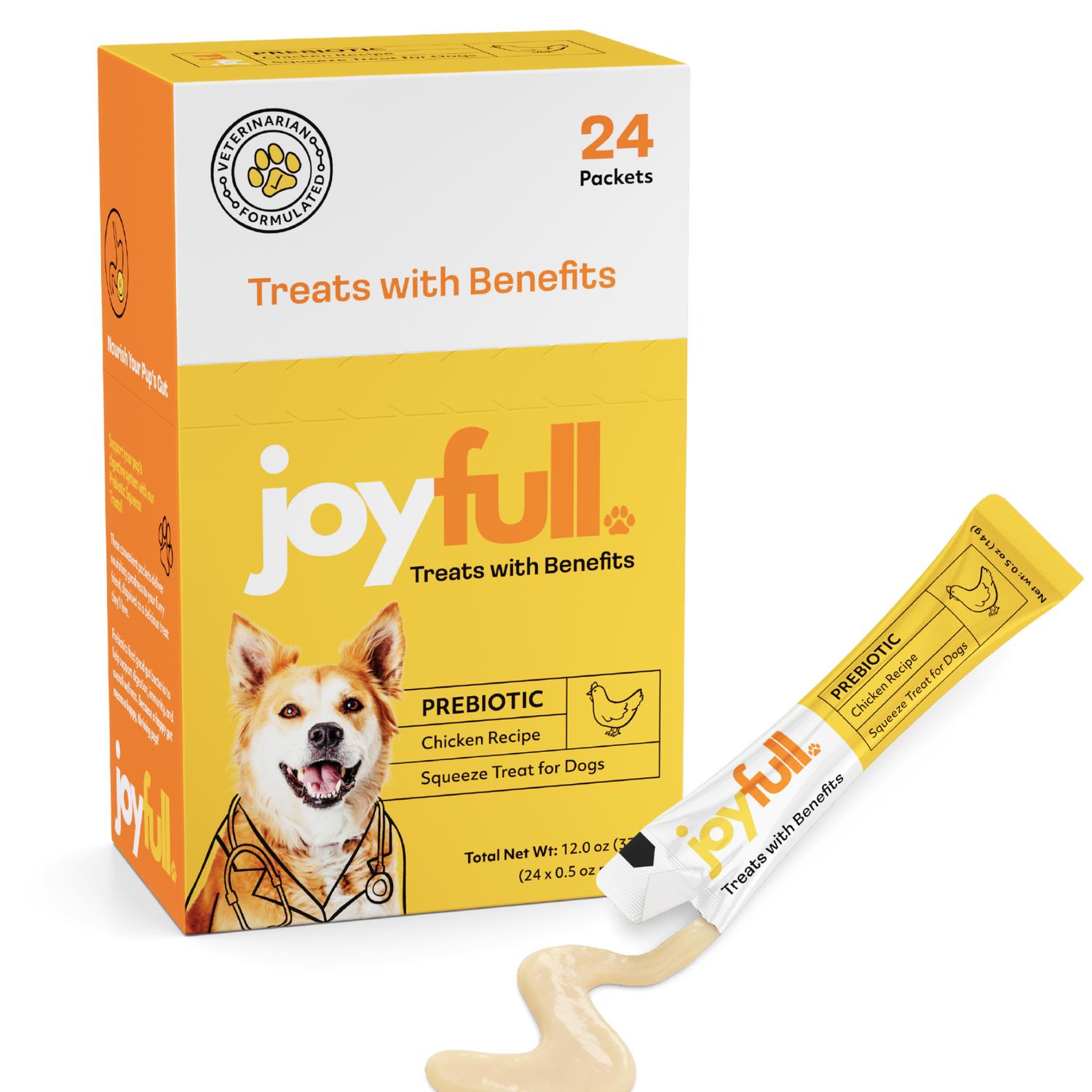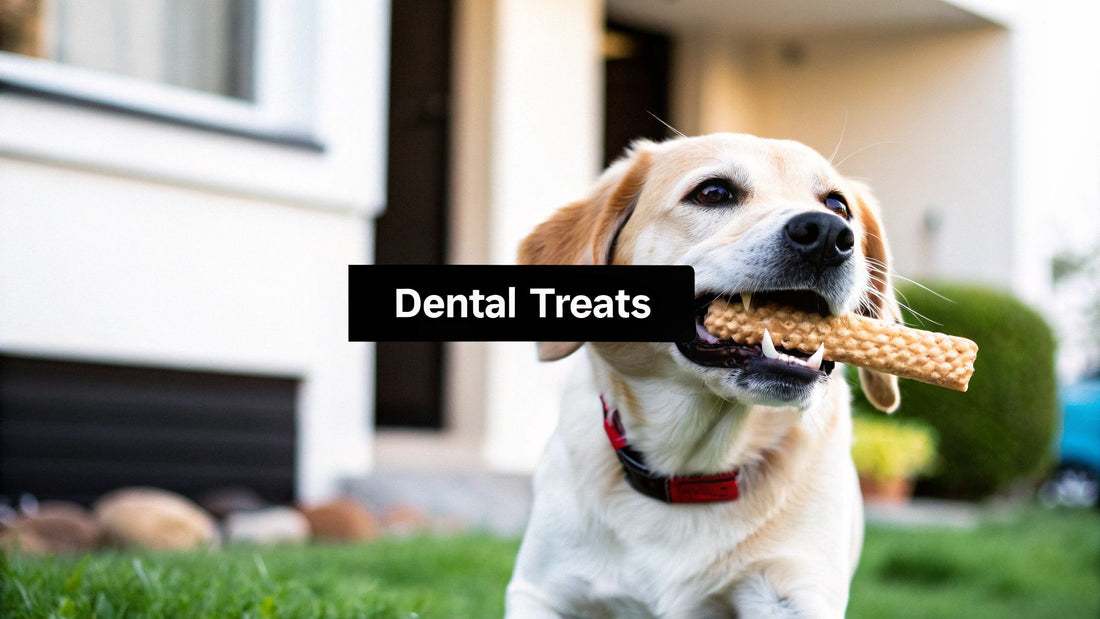
Top Picks: Best Dog Treats for Dental Health in 2024
When you're trying to find the best dental treats for your dog, it's easy to feel overwhelmed by the sheer number of options on the shelf. The good news is, you don't have to guess. The most effective treats work by physically scrubbing away plaque as your dog chews, and they're made with safe, easy-to-digest ingredients.
For a little extra confidence in your choice, keep an eye out for the VOHC (Veterinary Oral Health Council) seal. This is a big deal—it means the product has passed scientific trials and is proven to make a real difference in reducing plaque or tartar. It’s also crucial to match the treat's size and texture to your dog's specific needs to ensure it's both safe and effective.
How to Choose the Best Dental Treats for Your Dog
Picking the right dental treat isn't so different from choosing the right toothbrush for yourself. You look for specific features that promise a better clean, right? The same idea applies here. The best products have a few key things in common that set them apart from the rest.
The real magic happens through simple mechanical action. As your dog gnaws on the treat, its unique texture and shape should scrape away the nasty plaque that builds up on their teeth. This gentle abrasion is what helps keep their mouth healthy between professional cleanings.
What to Look for on the Label
When you're standing in the pet aisle, the product label is your best friend. A few key details can tell you everything you need to know about a treat's quality and whether it will actually work.
The VOHC Seal is the gold standard. When you see this seal, it means the Veterinary Oral Health Council has reviewed solid scientific evidence showing that the treat truly helps reduce plaque or tartar buildup. It's the closest thing to a guarantee you can get.
Beyond that seal, you'll want to think about the treat's physical characteristics. A great dental chew needs to be firm enough to provide a satisfying scrub but have enough give to prevent it from fracturing a tooth. Steer clear of rock-hard chews, as they can do more harm than good, especially if you have a powerful chewer on your hands.
Finally, size matters—a lot. Always choose a treat that’s the right size for your dog to avoid any choking hazards. A treat that’s too small can be swallowed whole, which not only defeats the purpose but can be incredibly dangerous.
To make it even easier, here’s a quick summary of what to look for when you're shopping.
Key Features of Effective Dog Dental Treats
| Feature | Why It Matters for Dental Health | What to Look For on the Label |
|---|---|---|
| Abrasive Texture | The treat's surface physically scrubs away plaque and tartar as the dog chews. This is the primary cleaning mechanism. | Look for words like "textured," "ridged," or "nubs." The treat should feel firm but not rock-hard. |
| VOHC Seal of Acceptance | This seal certifies that the product has been scientifically proven to effectively reduce plaque or tartar. | Look for the official VOHC logo on the packaging. The product will be listed on the VOHC website. |
| Appropriate Size & Shape | A treat that's too small is a choking hazard. The right size ensures the dog has to chew, not swallow it whole. | Check the weight/breed recommendations on the package. The treat should be larger than your dog's mouth. |
| Digestible Ingredients | Low-quality or indigestible ingredients can cause stomach upset. The treat should provide nutrition, not just a chew. | Read the ingredient list. Look for whole foods and avoid vague terms like "animal by-products." |
| Flexibility | Treats that are too hard can fracture teeth, leading to pain and expensive dental work. | The "thumbnail test": you should be able to press your thumbnail into the treat and leave an indent. |
Choosing a dental treat that checks all these boxes is a fantastic way to support your dog’s oral hygiene as part of a complete care routine.
Why Your Dog's Dental Health Is So Important
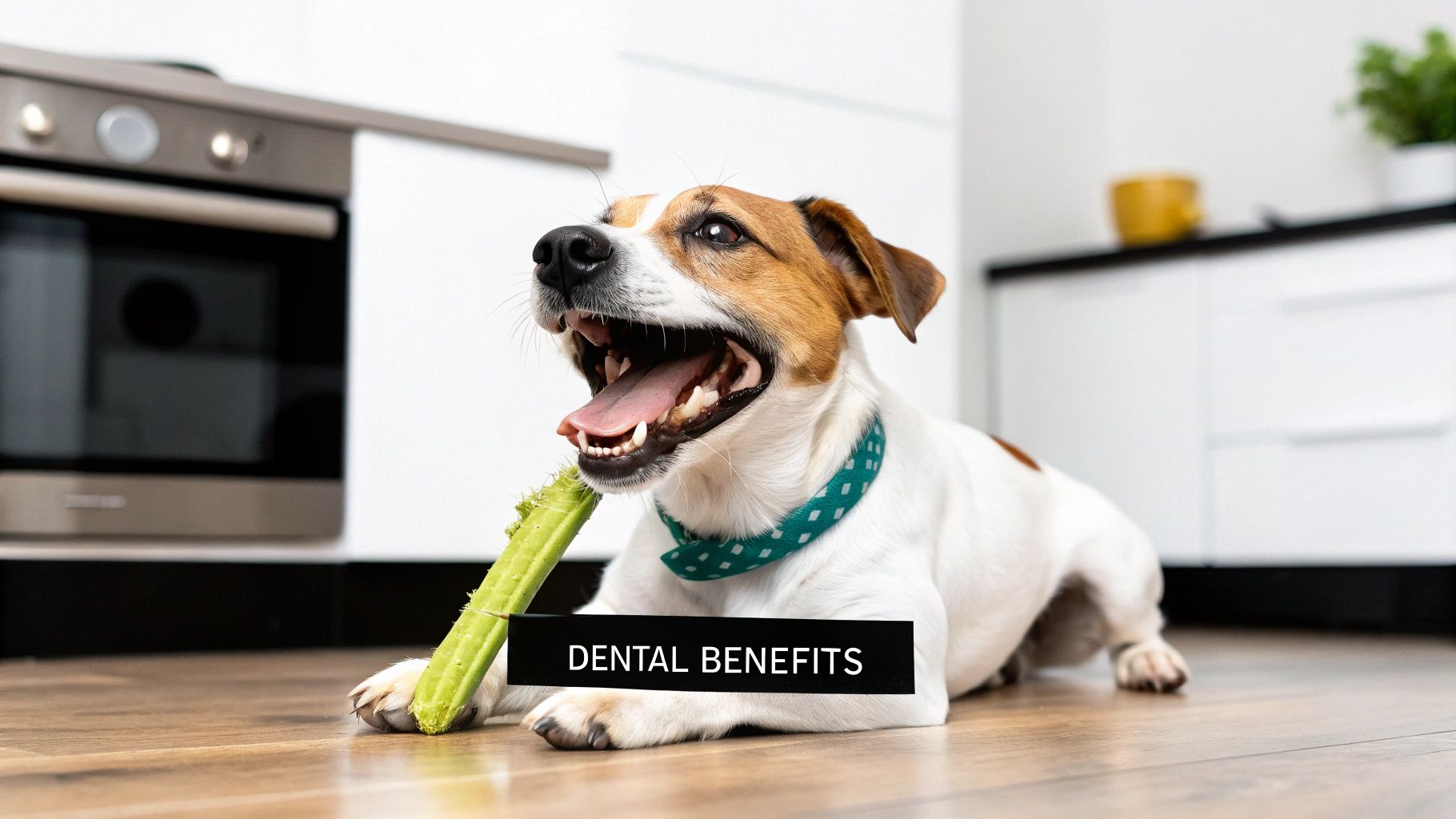
That happy, toothy grin on your dog’s face is more than just a cute expression—it’s a direct reflection of their overall health. It's easy for us as pet owners to dismiss bad breath as just "dog breath," a minor annoyance we have to live with. But in reality, your dog's mouth is a gateway to the rest of their body.
Think of it this way: the harmful bacteria that cause plaque and tartar don't just stay in the mouth. As those deposits build up, they irritate the gums, leading to inflammation and creating small openings for bacteria to slip into the bloodstream. This is the moment a simple dental issue can snowball into a much bigger health problem.
The Link Between Oral Health and Overall Wellness
Once those bacteria are in the bloodstream, they can travel to your dog's vital organs. Vets have known for years about the clear connection between advanced periodontal disease and serious health conditions affecting the heart, kidneys, and liver.
Suddenly, taking care of your dog’s teeth isn’t just about fresh breath or avoiding expensive cleanings. It’s one of the most powerful forms of preventative care you can provide. Unfortunately, this problem is incredibly common—an estimated 80% of dogs over age three already show signs of dental disease.
Preventative Care Is Key: Investing in your dog's dental health is one of the most impactful things you can do for their long-term well-being. A daily routine, including using the best dog treats for dental health, helps manage bacteria before they can cause systemic harm.
A Growing Awareness Among Pet Parents
The good news is that pet parents are catching on. More and more people are recognizing just how crucial proactive dental care is, and you can see this shift in the market.
The global market for pet dog dental treats was valued at around $2.5 billion in 2025 and is only expected to grow. This isn't just a trend; it's a sign that owners are getting serious about protecting their dogs' health from the inside out. You can learn about the expanding dental treat market and see how this focus on wellness is shaping the industry.
The Science Behind How Dental Treats Clean Teeth
It might seem a bit like magic—how can a simple treat actually help clean your dog's teeth? The secret isn't magic at all, but a clever combination of design and ingredients that taps into your dog's natural desire to chew. The best dental treats for dogs fight plaque and tartar in two key ways.
First up is mechanical abrasion. This is the most direct method. Think of it like a toothbrush for your pup. As your dog gnaws on a treat, its special shape—with all those ridges and nubs—physically scrapes against their teeth. This scrubbing action clears away loose food bits and plaque before they have a chance to harden into stubborn tartar.
The Power of Ingredients
Beyond just scrubbing, the most effective dental treats also use enzymatic action. This is the more subtle, chemical side of the cleaning process. Special enzymes are baked right into the treat's recipe to break down the sticky, slimy biofilm that plaque creates on teeth. This makes it much harder for new plaque to form and mineralize into tartar, which is a real pain to remove.
By combining the physical scrubbing of mechanical abrasion with the chemical cleaning of enzymatic action, a high-quality dental treat delivers a powerful one-two punch against poor oral health. It’s a simple, effective addition to your dog's daily care routine.
This infographic breaks down some of the powerhouse ingredients that make this process work.
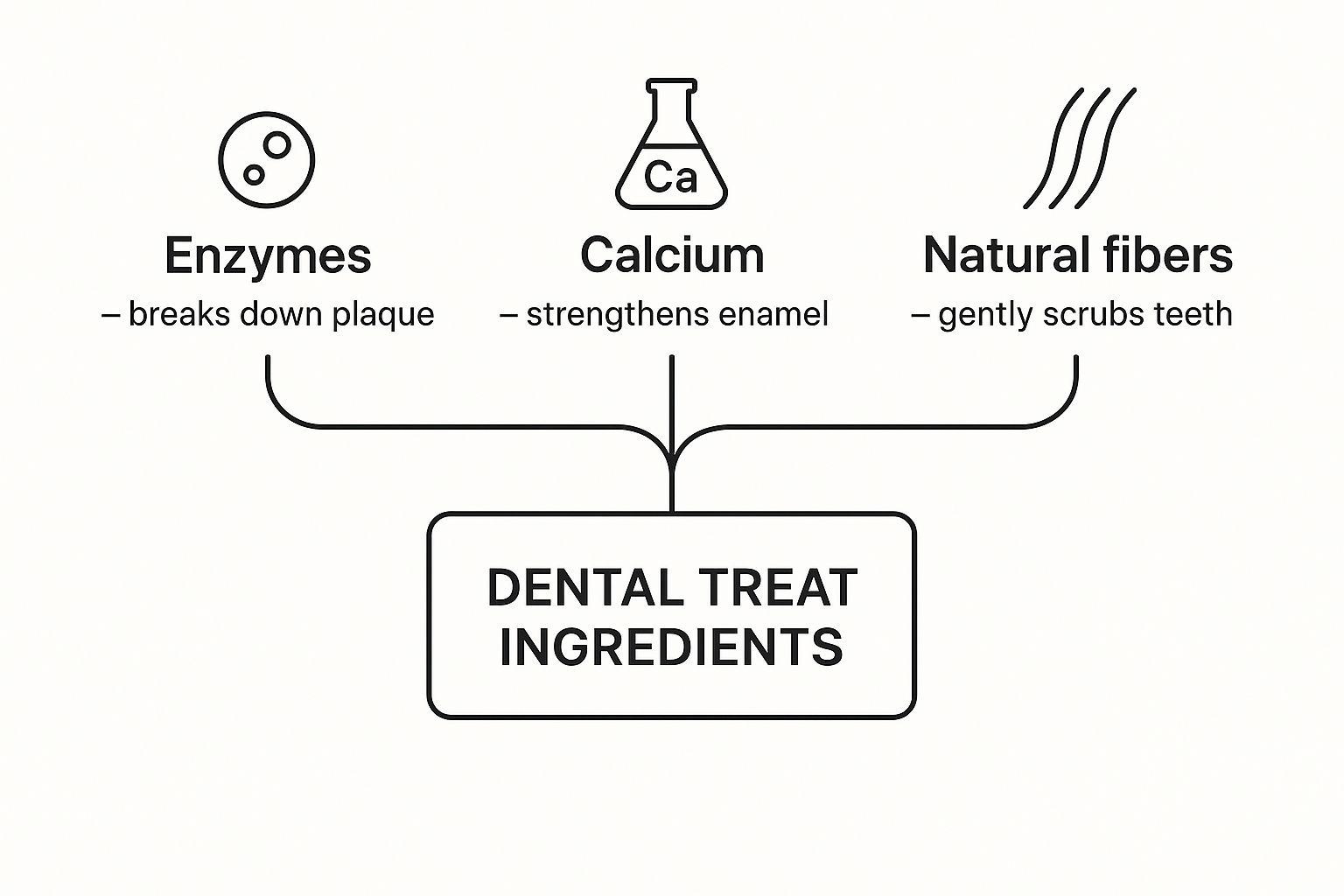
As you can see, every ingredient is chosen for a specific job, from scrubbing away grime to strengthening teeth. Understanding this dual-action approach is key, and you can dive deeper into how we've perfected it by exploring our science-backed formulation process.
More and more, pet parents are looking for preventative care solutions like these. The proof is in the numbers: the global market for dental treats, valued at $93 million in 2025, is expected to soar past $130 million by 2033. This incredible growth shows just how much owners value products that genuinely work.
Decoding the Ingredient List on Dental Treats
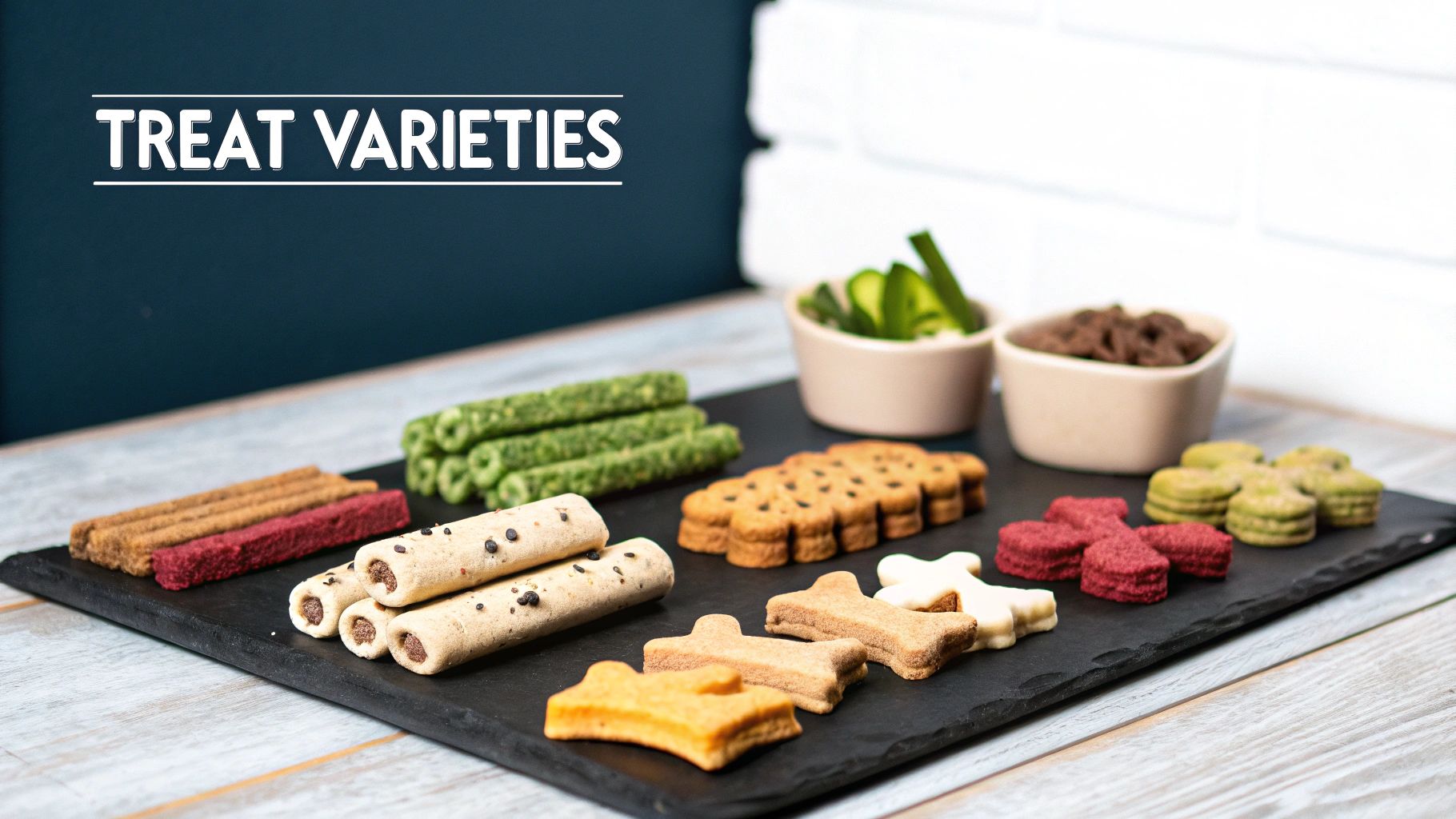
Ever flip over a bag of dog treats and feel like you need a secret decoder ring for the ingredient list? You're not alone. But once you know what to spot, that label becomes your best friend in finding a truly great dental treat. The goal is to find a product that’s full of purpose, not just empty fillers.
Think of it as having two mental lists: a "green-light" list of ingredients that actively help your dog's mouth, and a "red-flag" list of things you want to steer clear of. The best treats don't just work on teeth; they're also easy to digest and safe, contributing to your dog's overall health.
Green-Light Ingredients to Look For
These are the all-stars of the ingredient list. Seeing these names means the treat was formulated to do more than just taste good—it’s built for oral health.
- Active Ingredients: Keep an eye out for specific compounds proven to combat plaque. For example, an ingredient like delmopinol works by creating a barrier on the tooth surface, making it much harder for plaque to get a foothold.
- Natural Enzymes: You might see terms like "triple-enzymatic" formulas. These use enzymes to actively break down the sticky biofilm that hardens into tartar.
- Wholesome Binders: Ingredients like potato starch or pea flour are perfectly fine. They're what give the treat its chewy texture and hold it all together.
A treat's real value lies in these active components. They're what separate a simple snack from a functional dental tool that keeps working long after your dog has finished chewing.
Red-Flag Ingredients to Avoid
Knowing what to avoid is just as critical as knowing what to seek out. Some ingredients add nothing of value and can even cause problems for your pup.
- Vague Proteins: Be wary of terms like "meat by-products." A quality treat will be specific, naming its protein source, like "chicken" or "beef."
- Sugars and Sweeteners: Added sugars, such as corn syrup, are just empty calories that can actually worsen dental issues. And be absolutely certain to avoid xylitol, which is highly toxic to dogs.
- Artificial Colors and Flavors: Dyes like Red 40 or Blue 2 are only there to make the treat look more appealing to you, not your dog. They offer zero benefits.
- Excessive Fillers: Cheap fillers like corn and wheat are often used to bulk up a treat without adding much nutritional value.
Choosing treats with high-quality ingredients can offer benefits beyond a clean mouth. For instance, some of the same anti-inflammatory ingredients in premium dental chews can also support joint health. You can explore more on this topic in our guide to finding the right dog treats for arthritis.
Matching the Right Dental Chew to Your Dog

When it comes to dental chews, there's no magic "one-size-fits-all" solution. Every dog has a unique personality, and they bring that same energy to their chewing habits. The first step in picking a safe and effective chew is to honestly assess how your dog tackles a treat.
Are they a gentle nibbler who savors every moment? Or are they a power chewer, on a mission to destroy anything in their path? Knowing the difference is the secret to finding the best dog treats for their dental health.
This isn't just about preference—it's about safety. Give a power chewer a soft treat, and it'll be gone in a flash. Not only does that offer zero cleaning benefit, but it can also become a serious choking hazard. On the flip side, a chew that’s too hard for a gentle dog could risk a painful and expensive tooth fracture.
Finding the sweet spot is everything. A great dental treat is tough enough to make your dog work for it—that chewing action is what scrubs the teeth clean—but soft enough that you can make an indent with your thumbnail. It's a simple test, but it's a great way to gauge if a chew is too hard for your pup's mouth.
Chew Types and Your Dog’s Needs
To make the choice a little easier, let's look at the main types of chews and which dogs they're best suited for.
- Flexible Sticks: These softer, more pliable options are fantastic for senior dogs, puppies, and those gentle nibblers we mentioned. Their chewy texture still gets the job done without being too intense on their teeth and gums.
- Textured Bones: These are designed with all sorts of nubs, ridges, and unique shapes, making them perfect for your average, moderate chewer. Those different textures are engineered to get into all the nooks and crannies, cleaning the tooth surface and along the gum line.
- Durable Chews: Built tough for the most enthusiastic power chewers, these are made from longer-lasting ingredients that can stand up to a real workout. They’re designed to endure aggressive chewing while providing the friction needed to scrape away plaque.
It’s clear that dog owners are paying more attention to this than ever before. The dog dental chews market was valued at around $2.73 billion in 2025 and is expected to grow to $4.53 billion by 2035. This boom shows just how many of us are looking for the right dental solutions for our furry family members. You can read more about these market trends and insights to see how the industry is evolving.
Common Questions About Dog Dental Treats
Even when you know what to look for in a good dental treat, you probably still have a few questions. That’s perfectly normal. Taking care of your dog's teeth at home is a big responsibility, so let's walk through some of the most common uncertainties. My goal is to help you feel completely confident about your dog's oral care routine.
So, where do most pet parents start? Usually, it's with the simplest question: how often is too often?
How Often Should I Give My Dog Dental Treats?
For the vast majority of dogs, one dental treat per day is the sweet spot. Think of it just like brushing your own teeth—it’s the daily consistency that really pays off in the long run. Giving a treat here and there, say once a week, just won't have the same plaque-fighting power as making it a daily habit.
Of course, you should always start by reading the feeding guidelines on the package. And don't forget to factor that treat into your dog's total daily calories to keep them from packing on extra pounds. They're functional, but they're still treats!
Consistency Is Key: A daily dental chew is far more effective at preventing plaque buildup than an occasional treat. Make it a predictable part of your dog's routine to maximize the oral health benefits.
Can Dental Treats Replace Professional Teeth Cleaning?
This is a big one, and the answer is a firm no. Dental treats are an amazing tool for maintenance, but they are a supplement, not a substitute, for professional cleanings from your veterinarian. Think of them as your daily brushing, while a vet cleaning is like your own six-month visit to the dentist for a deep clean.
The best dog treats for dental health are fantastic at slowing down the accumulation of new plaque and tartar. What they can't do is remove tartar that has already hardened and calcified, especially the gunk hiding below the gumline. That’s a job that requires a vet's specialized tools and expertise.
Are There Any Risks With Dental Chews?
Yes, and it’s smart to be aware of them. The two biggest concerns with any chew are choking, which can happen if a dog gulps down a large piece, and tooth fractures if the chew is simply too hard. The good news is that both of these risks can be managed with a little bit of care.
Here’s how to keep your pup safe:
- Always supervise your dog when they’re enjoying a dental chew. Never just hand it over and walk away.
- Choose the right size for your dog. A treat that’s too small for a large dog is a serious choking hazard.
- Avoid rock-hard chews. A good rule of thumb is the "thumbnail test." If you can't press your thumbnail into the chew and leave an indent, it’s likely too hard for your dog’s teeth.
- Know your dog's chewing style. If you have a gulper, look for treats with unique shapes designed to encourage slower, more deliberate chewing.
Using dental treats can also be a fantastic opportunity for positive reinforcement, just like when you're working on commands. If you're looking for other ways to reward good behavior, check out our guide on the best training treats for dogs.
At JoyFull, we believe that taking care of your pet should be simple and effective. Our scientifically reviewed formulas are made with clean, high-quality ingredients, so you can feel good about giving your dog a treat that supports their overall wellness from snout to tail. Explore our products at https://joyfullpet.com and give your pet the best.
